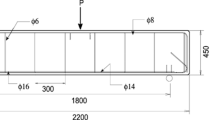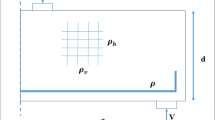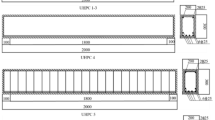Abstract
The use of fiber-reinforced polymer (FRP) to strength the concrete beams is an efficient method in retrofitting of preexisting structures. The application of FRP sheets makes to have higher shear strength, but the common equations in determining the shear strength are no longer effective. In this paper, a new formulation is presented to predict the shear contribution of FRP in strengthened reinforced concrete beams. The formula is produced using the multigene genetic programming (MGP) machine. For this purpose, a set of experimental data is collected from the literature. The shear capacity of FRP in reinforced concrete (RC) beams is considered as the output data, while other variables are considered as the input data. MGP is trained with the experimental data and a formula is produced. The results of the proposed formula are compared with the experimental data to show the ability of the proposed formula. Also, these results are compared with those obtained from the available formulas, approximation models and published researches. Results show that the proposed formula is able to predict the shear capacity of FRP in strengthened RC beams with a higher precision than the other evaluated methods such as CIDAR, Fib.TG9.3, ACI and CSA. The mean absolute percentage error for the MGP formula was reduced about 74% in comparison with the CIDAR equations. Also, the root-mean-squared-error of the MGP formula was decreased near 71% in comparison with the Fib.TG9.3 equations.















Similar content being viewed by others
References
Abdel-Jaber M, Walker P, Hutchinson A (2003) Shear strengthening of reinforced concrete beams using different configurations of externally bonded carbon fiber reinforced plates. Mater Struct 36:291–301
Abualigah LMQ (2019) Feature selection and enhanced krill herd algorithm for text document clustering. Springer, Cham
Abualigah LMQ, Hanandeh ES (2015) Applying genetic algorithms to information retrieval using vector space model. Int J Comput Sci Eng Appl 5:19–28. https://doi.org/10.5121/ijcsea.2015.5102
Abualigah LM, Khader AT (2017) Unsupervised text feature selection technique based on hybrid particle swarm optimization algorithm with genetic operators for the text clustering. J Supercomput 73:4773–4795. https://doi.org/10.1007/s11227-017-2046-2
Abualigah LM, Khader AT, Hanandeh ES (2018a) A combination of objective functions and hybrid krill herd algorithm for text document clustering analysis. Eng Appl Artif Intell 73:111–125. https://doi.org/10.1016/j.engappai.2018.05.003
Abualigah LM, Khader AT, Hanandeh ES (2018b) Hybrid clustering analysis using improved krill herd algorithm. Appl Intell 48:4047–4071. https://doi.org/10.1007/s10489-018-1190-6
Abualigah LM, Khader AT, Hanandeh ES (2018c) A new feature selection method to improve the document clustering using particle swarm optimization algorithm. J Comput Sci 25:456–466. https://doi.org/10.1016/j.jocs.2017.07.018
Abualigah LM, Khader AT, Hanandeh ES (2019) Modified krill herd algorithm for global numerical optimization problems. In: Shandilya SK, Shandilya S, Nagar AK (eds) Advances in nature-inspired computing and applications. Springer, Cham, pp 205–221
ACI Committee 440 (2008) Guide for the design and construction of externally bonded FRP systems for strengthening concrete structures. American Concrete Institute, Farmington Hills
Adhikary BB, Mutsuyoshi H (2004) Behavior of concrete beams strengthened in shear with carbon-fiber sheets. J Compos Constr 8:258–264
Adhikary B, Mutsuyoshi H, Ashraf M (2003) Effective shear strengthening of concrete beams using FRP sheets with bonded anchorage. In: Proceeding 6th international conference on fiber reinforced polymer reinforcement concrete structures (FRPRCS-6), Singapore. World Scientific, pp 457–466
Ali SH (2012a) Miner for OACCR: case of medical data analysis in knowledge discovery. In: 6th International conference on sciences of electronics, technologies of information and telecommunications (SETIT), Sousse, Tunisia, pp 962–975
Ali SH (2012b) A novel tool (FP-KC) for handle the three main dimensions reduction and association rule mining. In: 6th International conference on sciences of electronics, technologies of information and telecommunications (SETIT), Sousse, Tunisia, 951–961
Ali SH (2013) Novel approach for generating the key of stream cipher system using random forest data mining algorithm. In: 6th International conference on developments in eSystems engineering, Abu Dhabi, United Arab Emirates, pp 259–269
Al-Janabi S (2018) Smart system to create an optimal higher education environment using IDA and IOTs. Int J Comput Appl. https://doi.org/10.1080/1206212X.2018.1512460
Al-Janabi S, Alkaim AF (2019) A nifty collaborative analysis to predicting a novel tool (DRFLLS) for missing values estimation. Soft Computi. https://doi.org/10.1007/s00500-019-03972-x
Al-Janabi S, Alwan E (2017) Soft mathematical system to solve black box problem through development the FARB based on hyperbolic and polynomial functions. In:10th International conference on developments in eSystems engineering (DeSE), Paris, France, pp 37–42
Al-Janabi S, Mahdi MA (2019) Evaluation prediction techniques to achievement an optimal biomedical analysis. Int J Grid Util Comput 10:512–527. https://doi.org/10.1504/IJGUC.2019.10020511
Al-Janabi S, Alhashmi S, Adel Z (2019a) Design (More-G) model based on renewable energy and knowledge constraint. In: Farhaoui Y (ed) Big data and networks technologies. Springer, Cham, pp 271–295
Al-Janabi S, Yaqoob A, Mohammad M (2019b) Pragmatic method based on intelligent big data analytics to prediction air pollution. In: Farhaoui Y (ed) Big data and networks technologies. Springer, Cham, pp 84–109
Alkaim AF, Al-Janabi S (2019) Multi objectives optimization to gas flaring reduction from oil production. In: Farhaoui Y (ed) Big data and networks technologies. Springer, Cham, pp 117–139
Al-Mosawe A, Kalfat R, Al-Mahaidi R (2017) Strength of Cfrp-steel double strap joints under impact loads using genetic programming. Compos Struct 160:1205–1211
Araki N, Matsuzaki Y, Nakano K, Kataoka T, Fukuyama H (1997) Shear capacity of retrofitted RC members with continuous fiber sheets. In: Non-metallic (FRP) reinforcement for concrete structures, proceedings of the third symposium, pp 515–522
Barros JA, Dias SJ (2006) Near surface mounted CFRP laminates for shear strengthening of concrete beams. Cem Concr Compos 28:276–292
Beber AJ, Campos Filho A (2005) CFRP composites on the shear strengthening of reinforced concrete beams. Rev IBRACON Estruturas 1
Berset J-D (1992) Strengthening of reinforced concrete beams for shear using FRP composites. Massachusetts Institute of Technology, Cambridge
Bousselham A, Chaallal O (2006) Effect of transverse steel and shear span on the performance of RC beams strengthened in shear with CFRP. Compos Part B Eng 37:37–46
Bousselham A, Chaallal O (2008) Mechanisms of shear resistance of concrete beams strengthened in shear with externally bonded FRP. J Compos Constr 12:499–512
Brameier MF, Banzhaf W (2007) Linear genetic programming. Springer, Cham
Cai H, Aref AJ (2015) A genetic algorithm-based multi-objective optimization for hybrid fiber reinforced polymeric deck and cable system of cable-stayed bridges. Struct Multidiscip Optim 52:583–594. https://doi.org/10.1007/s00158-015-1266-4
Cao S, Chen J, Teng J, Hao Z, Chen J (2005) Debonding in RC beams shear strengthened with complete FRP wraps. J Compos Constr 9:417–428
Chajes MJ, Januszka TF, Mertz DR, Thomson TA, Finch WW (1995) Shear strengthening of reinforced concrete beams using externally applied composite fabrics. Struct J 92:295–303
CIDAR (2006) Design guideline for RC structures retrofitted with FRP and metal plates: beams and slabs, Draft 3. Submitted to Standards Australia, The University of Adelaide
Colomb F, Tobbi H, Ferrier E, Hamelin P (2008) Seismic retrofit of reinforced concrete short columns by CFRP materials. Compos Struct 82:475–487. https://doi.org/10.1016/j.compstruct.2007.01.028
CSA-S806-12 (2012) Design and construction of building components with fibre-reinforced polymers. Canadian Standards Association, Mississauga
De Lorenzis L, Tepfers R (2003) Comparative study of models on confinement of concrete cylinders with fiber-reinforced polymer composites. J Compos Constr 7:219–237. https://doi.org/10.1061/(ASCE)1090-0268(2003)7:3(219)
Deniaud C, Cheng JR (2001) Shear behavior of reinforced concrete T-beams with externally bonded fiber-reinforced polymer sheets. Struct J 98:386–394
Deniaud C, Roger Cheng J (2003) Reinforced concrete T-beams strengthened in shear with fiber reinforced polymer sheets. J Compos Constr 7:302–310
Diagana C, Li A, Gedalia B, Delmas Y (2003) Shear strengthening effectiveness with CFF strips. Eng Struct 25:507–516
Dolan C, Rider W, Chajes M, DeAscanis M (1993) Prestressed concrete beams using non-metallic tendons and external shear reinforcement. Fiber Reinf Plast Reinf Concr Struct Am Concr Inst SP 138:475–496
Ebrahimpour Komleh H, Maghsoudi A (2015) Prediction of curvature ductility factor for FRP strengthened RHSC beams using ANFIS and regression models. Comput Concr 16:399–414
Feng X, Zhong Fan H (2004) Experimental research on shear strengthening of reinforced concrete beams with externally bonded CFRP sheets. Ind Buiding 34:89–93 (In Chinese)
Fib-TG9.3 (2001) Design and use of externally bonded fiber reinforced polymer reinforcement (FRP EBR) for reinforced concrete structures. International Federation for Structural Concrete, Lausanne
Gamino AL, Sousa J, Manzoli OL, Bittencourt TN (2010) R/C structures strengthened with CFRP part II: analysis of shear models. Revista IBRACON de Estruturas e Materiais 3:24–49
Gandomi A, Alavi A, Yun G (2011) Nonlinear modeling of shear strength of SFRC beams using linear genetic programming. Struct Eng Mech 38:1–25
Hüsken M, Jin Y, Sendhoff B (2005) Structure optimization of neural networks for evolutionary design optimization. Soft Comput 9:21–28
Jayaprakash J, Samad AAA, Abbasovich AA, Ali AAA (2008) Shear capacity of precracked and non-precracked reinforced concrete shear beams with externally bonded bi-directional CFRP strips. Constr Build Mater 22:1148–1165
Kaghed NH, Abbas TA, Ali SH (2006) Design and implementation of classification system for satellite images based on soft computing techniques. In: 2nd International conference on information and communication technologies, Damascus, Syria, pp 430–436
Kalfat R, Nazari A, Al-Mahaidi R, Sanjayan J (2016) Genetic programming in the simulation of Frp-to-concrete patch-anchored joints. Compos Struct 138:305–312
Kamgar R, Hatefi SM, Majidi N (2018) A fuzzy inference system in constructional engineering projects to evaluate the design codes for RC buildings. Civ Eng J 4:2155–2172. https://doi.org/10.28991/cej-03091147
Kara IF (2011) Prediction of shear strength of FRP-reinforced concrete beams without stirrups based on genetic programming. Adv Eng Softw 42:295–304
Karbhari VM (2015) Rehabilitation of pipelines using fiber-reinforced polymer (FRP) composites. Woodhead Publishing, Waltham
Khalifa A (1999) Shear performance of reinforced concrete beams strengthened with advanced composites. DISS. University of Alexandria, Egypt
Khalifa A, Nanni A (2000) Improving shear capacity of existing RC T-section beams using CFRP composites. Cem Concr Compos 22:165–174
Koza JR (1992) Genetic programming, on the programming of computers by means of natural selection. MIT Press, London
Koza JR (1994) Genetic programming as a means for programming computers by natural selection. Stat Comput 4:87–112
Lee S, Lee C (2014) Prediction of shear strength of FRP-reinforced concrete flexural members without stirrups using artificial neural networks. Eng Struct 61:99–112
Li W, Leung CK (2016) Shear span–depth ratio effect on behavior of RC beam shear strengthened with full-wrapping FRP strip. J Compos Constr 20:04015067. https://doi.org/10.1061/(ASCE)CC.1943-5614.0000627
Li A, Diagana C, Delmas Y (2002) Shear strengthening effect by bonded composite fabrics on RC beams. Compos Part B Eng 33:225–239
Mahdi MA, Al-Janabi S (2019) A novel software to improve healthcare base on predictive analytics and mobile services for cloud data centers. In: Farhaoui Y (ed) Big data and networks technologies. Springer, Cham, pp 320–339
Miyajima H, Kosa K, Tasaki K, Matsumoto S (2005) Shear strengthening of RC beams using carbon fiber sheets and its resistance mechanism. In: Proceedings, pp 114–125
Miyauchi K, Inoue S, Nishibayashi S, Tanaka Y (1998) Shear behavior of reinforced concrete beam strengthened with CFRP sheet. Trans Jpn Concr Inst 19:97–104
Mofidi A, Chaallal O (2011) Shear strengthening of RC beams with externally bonded FRP composites: effect of strip-width-to-strip-spacing ratio. J Compos Constr 15:732–742
Monti G (2007) Tests and design equations for FRP-strengthening in shear. Constr Build Mater 21:799–809
Mousavi SM, Alavi AH, Gandomi AH, Arab Esmaeili M, Gandomi M (2010) A data mining approach to compressive strength of CFRP-confined concrete cylinders. Struct Eng Mech 36:759–783
Naderpour H, Alavi S (2017) A proposed model to estimate shear contribution of FRP in strengthened RC beams in terms of adaptive neuro-fuzzy inference system. Compos Struct 170:215–227
Nedjah N, Abraham A, de Macedo Mourelle L (2009) Genetic systems programming: theory and experiences. Springer Publishing Company, Incorporated, Cham
Niroomandi A, Maheri A, Maheri MR, Mahini S (2010) Seismic performance of ordinary RC frames retrofitted at joints by FRP sheets. Eng Struct 32:2326–2336. https://doi.org/10.1016/j.engstruct.2010.04.008
Ono K, Matsumura M, Sakanishi S, Miyata K (1997) Strength improvement of RC bridge piers by carbon fiber sheet. In: Non-metallic (FRP) reinforcement for concrete structures, vol 1. Japan Concrete Institute, pp 563–570
Ozcan O, Binici B, Ozcebe G (2008) Improving seismic performance of deficient reinforced concrete columns using carbon fiber-reinforced polymers. Eng Struct 30:1632–1646. https://doi.org/10.1016/j.engstruct.2007.10.013
Panda K, Bhattacharyya S, Barai S (2013) Effect of transverse steel on the performance of RC T-beams strengthened in shear zone with GFRP sheet. Constr Build Mater 41:79–90
Park S, Naaman A, Lopez M, Till R (2001) Shear strengthening effect of RC beams using glued CFRP sheets. In: FRP composites in civil engineering. Proceedings of the international conference on FRP composites in civil engineering Hong Kong Institution of Engineers, Hong Kong Institution of Steel Construction
Promis G, Ferrier E, Hamelin P (2009) Effect of external FRP retrofitting on reinforced concrete short columns for seismic strengthening. Compos Struct 88:367–379. https://doi.org/10.1016/j.compstruct.2008.04.019
Salman MA, Ali SH (2007) Knowledge discovery in data mining using fuzzy c-means model and genetic programming. In: 4th International conference: sciences of electronic, technologies of information and telecommunications, SETIT 2007, Tunisia
Sas G, Täljsten B, Barros J, Lima J, Carolin A (2009) Are available models reliable for predicting the FRP contribution to the shear resistance of RC beams? J Compos Constr 13:514–534
Sato Y, Ueda T, Kakuta Y, Tanaka T (1996) Shear reinforcing effect of carbon fiber sheet attached to side of reinforced concrete beams. In: Proceedings of the 2nd International conference on advanced composite materials in bridges and structures, ACMBS-II, Montreal
Searson DP, Leahy DE, Willis MJ (2010) GPTIPS: an open source genetic programming toolbox for multigene symbolic regression. In: Proceedings of the international multiconference of engineers and computer scientists, pp 77–80
Taerwe L, Khalil H, Matthys S (1997) Behaviour of RC beams strengthened in shear by external CFRP sheets. In: Proceedings of the third international symposium on non-metallic (FRP) reinforcement for concrete structures (FRPRCS-3), Sapporo, Japan
Tanarslan H (2011) Predicting the capacity of RC beams strengthened in shear with side-bonded FRP reinforcements using artificial neural networks. Compos Interfaces 18:587–614
Tanarslan H, Secer M, Kumanlioglu A (2012) An approach for estimating the capacity of RC beams strengthened in shear with FRP reinforcements using artificial neural networks. Constr Build Mater 30:556–568. https://doi.org/10.1016/j.conbuildmat.2011.12.008
Teng J, Chen G, Chen J, Rosenboom O, Lam L (2009) Behavior of RC beams shear strengthened with bonded or unbonded FRP wraps. J Compos Constr 13:394–404. https://doi.org/10.1061/(ASCE)CC.1943-5614.0000040
Uji K (1992) Improving shear capacity of existing reinforced concrete members by applying carbon fiber sheets. Trans Jpn Concr Inst 14:253–266
Umezu K (1997) Shear behavior of RC beams with aramid fiber sheet, Japan Concrete Institute, non-metallic (FRP) reinforcement for concrete structures. In: Proceeding of the third international symposium, pp 491–498
Wu H-C, Eamon CD (2017) Strengthening of concrete structures using fiber reinforced polymers (FRP): design, construction and practical applications. Woodhead Publishing, Cambridge
Xu Y, Gao Y, Wu C, Fang J, Li Q (2019) Robust topology optimization for multiple fiber-reinforced plastic (FRP) composites under loading uncertainties. Struct Multidiscip Optim 59:695–711. https://doi.org/10.1007/s00158-018-2175-0
Zhang Z, Hsu C-TT, Moren J (2004) Shear strengthening of reinforced concrete deep beams using carbon fiber reinforced polymer laminates. J Compos Constr 8:403–414
Acknowledgements
The authors would like to show their appreciations to HPC center (Shahr-e-Kord University, Iran) for their collaboration in offering computational clusters, which was a great help to complete this work. This study has not been funded.
Author information
Authors and Affiliations
Corresponding author
Ethics declarations
Conflict of interest
The authors declare that they have no conflict of interest.
Ethical approval
This article does not contain any studies with animal/human participants performed by any of the authors.
Additional information
Communicated by V. Loia.
Publisher's Note
Springer Nature remains neutral with regard to jurisdictional claims in published maps and institutional affiliations.
Rights and permissions
About this article
Cite this article
Kamgar, R., Bagherinejad, M.H. & Heidarzadeh, H. A new formulation for prediction of the shear capacity of FRP in strengthened reinforced concrete beams. Soft Comput 24, 6871–6887 (2020). https://doi.org/10.1007/s00500-019-04325-4
Published:
Issue Date:
DOI: https://doi.org/10.1007/s00500-019-04325-4




